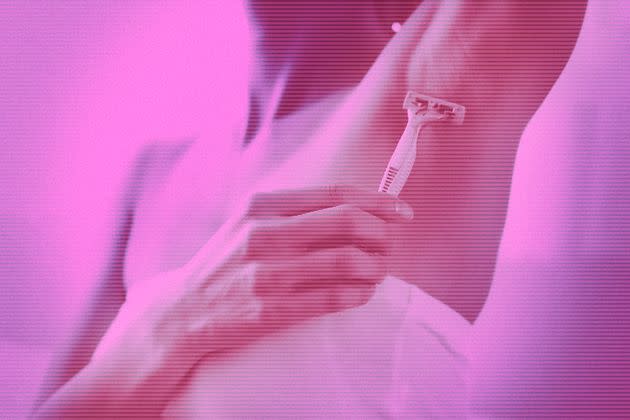So THAT'S Why Your Armpits Look Dark After Shaving

The goal: smooth, hairless underarms. The problem? The dark, shadowy underarms that result when you shave — and it’s not a five-o’clock shadow, but an actual darkening of the skin. So what even is this, exactly?
We spoke to experts to find out why post-shaving darkness occurs, how to prevent it, and tips for treating it.
The characteristics of underarm skin
The skin on the underarms is unique because it’s softer, thinner and more sensitive compared to other areas of the body, said Dr. Kautilya Shaurya, a board-certified dermatologist at Schweiger Dermatology Group. Often referred to as an intertriginous area, or a part of the body where two skin surfaces rub against each other, the underarms are prone to chafing, especially if you tend to sweat heavily or you wear tight clothing.
Also, because the underarms have folds, this can lead to trapped moisture and bacteria, which make the area prone to irritation. “The underarms have a high concentration of sweat glands and hair follicles, which means that the skin here experiences more friction and is more sensitive to certain activities like shaving or using deodorants,” Shaurya said.
Why do armpits look dark after shaving?
“Hyperpigmentation in the armpits is often the result of post-inflammatory hyperpigmentation,” said Dr. Hadley King, a board-certified dermatologist based in New York.
In this case, aggressive shaving can “traumatize the hair follicles, leading to irritation, inflammation and, subsequently, post-inflammatory hyperpigmentation,” said Dr. David Li, a board-certified dermatologist.
Shaving without a lubricant (such as shaving cream, body wash or soap) can also be the culprit. As Shaurya explained, this increases the friction between the razor and the skin, causing more irritation, nicks and cuts that lead to inflammation and, eventually, hyperpigmentation. “Lubricants help the razor glide smoothly over the skin, minimizing damage and the risk of darkening,” he added. Shaving with no lubricant can also cause painful red bumps and rashes.
Your skin tone and hair texture can play a role in post-shaving hyperpigmentation, too. “If someone’s baseline skin tone is darker, this suggests they have more melanin in the skin, which means that more melanin is released after trauma or microabrasions to the skin,” Li said. Similarly, thicker hairs, as well as curly or coiled hair, may be more prone to shaving irritation and subsequent discoloration.
Finally, irritating or drying ingredients in antiperspirants and deodorants can potentially cause inflammation followed by post-inflammatory hyperpigmentation, King said. “The potential for irritation may be increased if these products are applied to freshly shaved skin.”
How to prevent dark armpits after shaving
Some people have a genetic predisposition to hyperpigmentation. Even so, there are a few rules of thumb you can follow when it comes to shaving the underarms. Always make sure to shave with a clean, sharp razor, since a dull razor can create friction as it tries to cut down the hair. “The result is a tugging motion at the base of the hair shaft and the hair follicle, which can create inflammation and lead to post-inflammatory hyperpigmentation,” Li said.
Before shaving, King recommends spending about 10 minutes in warm water to help soften the outer layer of skin, which makes it easier to remove the hair and decreases the risk of razor burn. It’s also good to gently and lightly exfoliate with a warm wet washcloth or a gentle scrub containing exfoliants — this helps release any ingrown hairs stuck under the surface of dead skin prior to shaving, King said. If you’re shaving your underarms while you’re out of the shower, make sure to remove any product in this area, such as deodorant, and use some type of lubricant.
While shaving, you should always use short, light strokes and move in the direction of hair growth. Avoid doing multiple passes on the same area, since that can cause ingrown hairs and trauma to the skin, Shaurya said. And always ensure you’re using a clean, sharp razor.
In terms of aftercare, wait at least 15 to 30 minutes before applying deodorant to allow the skin to recover. “Use a gentle moisturizer or a post-shave balm with calming ingredients like aloe vera, glycerin or vitamin E to hydrate the skin and reduce irritation,” Shaurya said. “Also, avoid products with alcohol or strong fragrances, as they can be drying.”
How to treat dark armpits
If there’s no hormonal or genetic component to your underarm darkness and it’s truly caused by shaving-related trauma or irritation, there are a few ways to treat it. Underarm brightening creams with ingredients like niacinamide, kojic acid or vitamin C can help lighten dark spots and even out the skin tone, Shaurya said. Just know that results can take time, and it’s always good to patch test the product to ensure it’s compatible with your skin type.
Professional treatments, such as microdermabrasion or laser therapy, can also be effective in addressing more persistent hyperpigmentation, Shaurya said. And maintaining proper hygiene and reducing friction by wearing loose, breathable clothing can prevent further darkening.
You can also consider a different form of hair removal. Waxing, which removes hair from the root, and laser hair removal, which targets the hair follicle and reduces hair growth over time, are less likely to cause skin darkening because they don’t involve repetitive irritation like shaving, Shaurya said. If all else fails, it may be worth a visit to a board-certified dermatologist for an individualized treatment plan.
